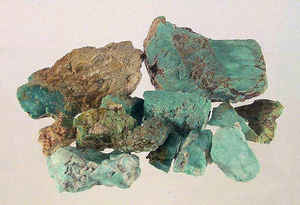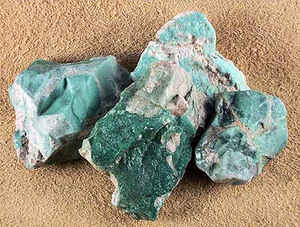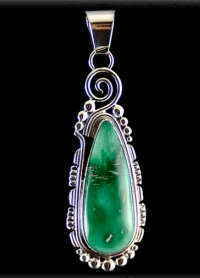Nevada State Semi Gemstone or Gem
Nevada Turquoise

(Hydrated Copper Aluminum Phosphate)
Adopted on May 27, 1987.
Turquoise, (Hydrated Copper Aluminum Phosphate,) is Nevada's semi-precious gemstone. Sometimes called the "jewel of the desert," Nevada turquoise is found in many parts of the state. Long popular as jewelry among Native Americans, turquoise is also a state symbol of Arizona and New Mexico. Nevada's designation was made on May 27, 1987.
Nevada Turquoise:
Nevada State Semi Precious Gemstone or Gem

Prehistoric peoples of the Western hemisphere knew of the turquoise as we have found pieces in burial and archeological sites throughout the two continents. The Anasazi and Hohokam mined turquoise throughout our Southwest. Absolute evidence exists that these prehistoric people mined turquoise at Cerillos and the Burro Mountains of New Mexico, Kingman and Morenci in Arizona and the Conejos areas of Colorado. Turquoise was a popular trade item as so much has been found in archeological sites many hundreds of miles away from its source. A prime example is the Cerillos, New Mexico, turquoise found with the Aztecs.
Turquoise, as mentioned earlier, was a very important item to the early inhabitants of both North and South America. The stone was used in religion, art, trade, treaty negotiations as well as for jewelry. It was considered by some to be associated with life itself.
The Apache believed that turquoise helped warriors and hunters to aim accurately. Clear sky blue with no green modifying color and no black veins running through is also produced in Arizona and New Mexico. In general the bluer the blue, the more highly valued. A clear even texture without mottling or veins is also preferred. However, some people prefer turquoise with veins, sometimes called spider webs, which set off the color.
The first Nevada turquoise discovery made by prospectors of European decent was made near Columbus in the early 1870s. At that time, it was only the second turquoise deposit in the US known to European miners. When Turquoise became fashionable during the period 1908 - 1910, the high prices attracted the attention of local prospectors and a number of new Nevada turquoise discoveries were made. Most of the turquoise discoveries made at that time were located in the Esmerelda/Mineral/Nye counties area which is the part of Nevada located nearest to that first 1870s discovery. By the late 1920's and 1930's turquoise once more came back into vogue, and increased prices again led to a number of new discoveries, and this time most of the new finds were located in Lander County, farther to the north. In the 1960s and 1970s, increased turquoise prices again led to new discoveries and production at mines all across Nevada, most notably the deposits at Carico Lake. Nevada has been a major producer of turquoise since the 1920s, and until the early 1980's, the State was the largest producer in the US. In this era of small turquoise operations, it may again be the largest producer. It is estimated that over the years, more than 100 different mines and prospects located in Nevada have produced significant quantities of turquoise, much of it of very good to excellent quality. That number far exceeds the total number of turquoise deposits all in the rest of the US combined. Production from these mines varied from a few thousand dollars worth of material at some of the smaller properties to many millions of dollars at the more productive ones. To date, the total value of the rough turquoise from the state of Nevada is estimated to comfortably exceed $250 million dollars.
Turquoise's color ranges from sky blue to green. Turquoise is a vibrant light blue stone often seen in southwestern jewelry. It is reasonably priced and quite lovely.
DECEMBER Birthstone

Turquoise:
The name turquoise, from the French expression Pierre tourques or Turkish stone, originated in the thirteenth century and describes one of
the oldest known gemstones. Its name is believed to originate from the French phrase "pierre turquoise"meaning "Turkish stone"because
turquoise was brought to Europe by Venetian merchants who first acquired it in Turkish bazaars. Turquoise varies in color from greenish blue, through
robin's egg-blue, to sky blue shades and its transparency ranges from translucent to opaque. Turquoise is plentiful and is available in a wide range
of sizes. It is most often used for beads, cabochons, carvings, and inlays. Although its popularity fluctuates in fashion, it is a perennial favorite
in the American Southwest.
Nevada Law
The law designating the Nevada turquoise as the official Nevada state semiprecious gemstone is found in the Nevada Revised Statutes, Title 19, Chapter 235, Section 235.100.
TITLE 19 - MISCELLANEOUS MATTERS RELATED TO GOVERNMENT AND PUBLIC AFFAIRS.
CHAPTER 235. STATE EMBLEMS; GIFTS AND ENDOWMENTS, MISCELLANEOUS SYMBOLS.
SECTION 235.110.
NRS 235.110 State semiprecious gemstone. The semiprecious gemstone known as Nevada turquoise is hereby designated as the official state semiprecious
gemstone of the State of Nevada.
(Added to NRS by 1987, 456)
Minerals, & Gems

Gemstone, Minerals, Rocks







